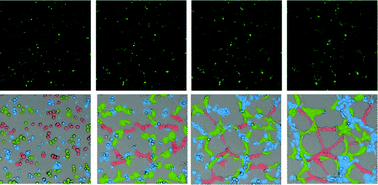A nanobiosensor for dynamic single cell analysis during microvascular self-organization†
Abstract
The formation of microvascular networks plays essential roles in regenerative medicine and tissue engineering. Nevertheless, the self-organization mechanisms underlying the dynamic morphogenic process are poorly understood due to a paucity of effective tools for mapping the spatiotemporal dynamics of single cell behaviors. By establishing a single cell nanobiosensor along with live cell imaging, we perform dynamic single cell analysis of the morphology, displacement, and gene expression during microvascular self-organization. Dynamic single cell analysis reveals that endothelial cells self-organize into subpopulations with specialized phenotypes to form microvascular networks and identifies the involvement of Notch1-Dll4 signaling in regulating the cell subpopulations. The cell phenotype correlates with the initial Dll4 mRNA expression level and each subpopulation displays a unique dynamic Dll4 mRNA expression profile. Pharmacological perturbations and RNA interference of Notch1-Dll4 signaling modulate the cell subpopulations and modify the morphology of the microvascular network. Taken together, a nanobiosensor enables a dynamic single cell analysis approach underscoring the importance of Notch1-Dll4 signaling in microvascular self-organization.


 Please wait while we load your content...
Please wait while we load your content...